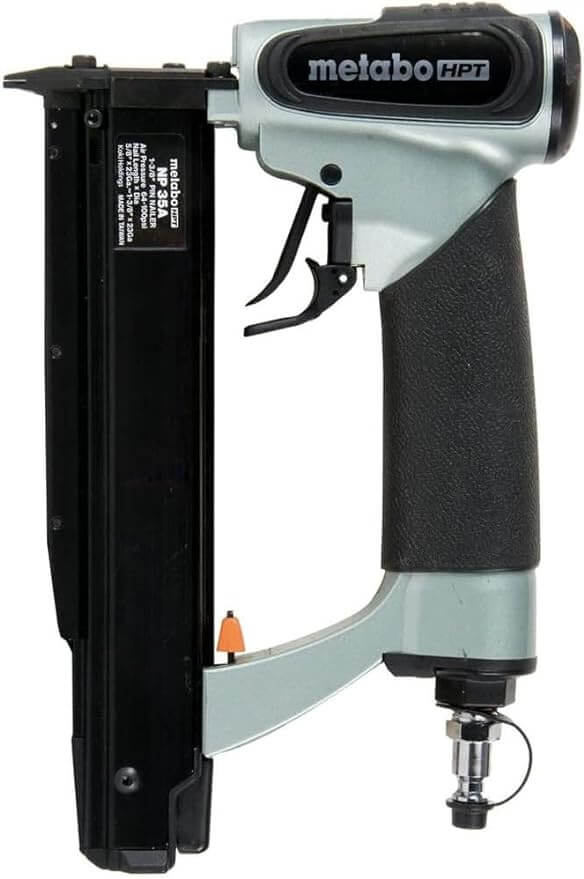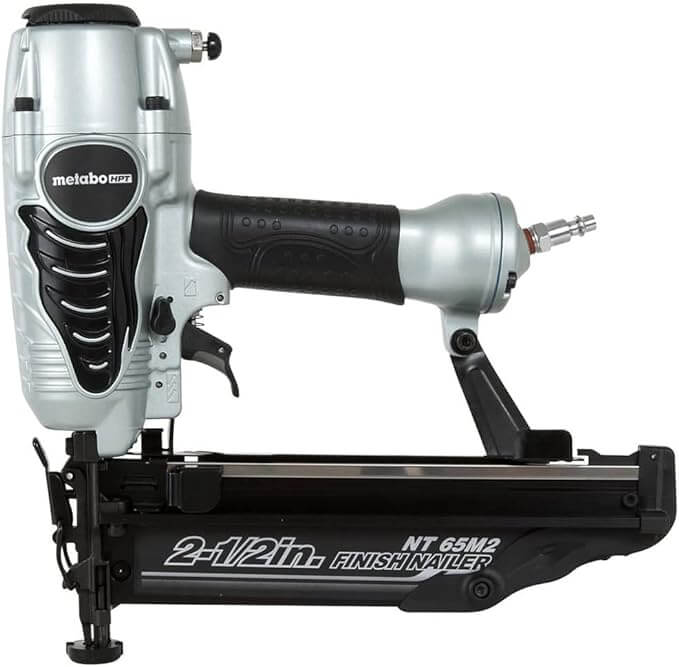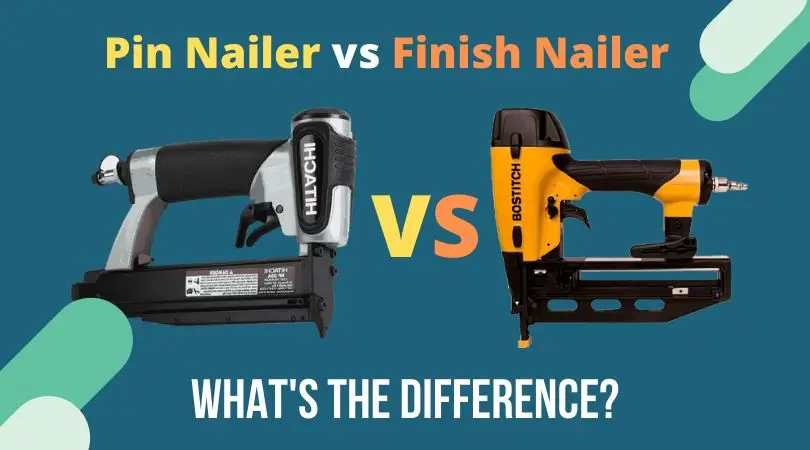Pin nailer vs Finish Nailer – When it comes to choosing the best tool for the job, there are a lot of factors to consider. Do you want a tool that’s easy to use and fast? Do you want a tool that can handle a variety of materials and projects? Or one that’s low-maintenance and durable? A pin nailer and a finish nailer are some of the best nailers for woodworkers because of their easy maneuverability.
In this article, we will explain the difference between pin nailer and finish nailer. We’ll look at the features, pros, and cons of each type of tool So that you can pick the best one for your needs.
Features of Pin Nailer

Pin nailers are one of the most popular choices among woodworkers. A pin nailer is smaller and lightweight than a finish nailer, making it easy to maneuver. Plus, they’re perfect for delicate projects that require precision.
However, an electric pin nail gun has its limitations. For example, they’re not ideal for thicker pieces of wood because the nails are so thin. Pin nailers use 23 gauge nails. This is the thinnest headless nail size operating in nail guns. These headless nails or pins are perfect for delicate projects like light trimming, photo frames, and molding.
A pin nail gun also known as a micro pinner, drives in thin fasteners that resemble stiff wires. These pins come in the form of a stack and are inserted into the finish or brad nailers similarly.
The main difference between a pin nailer and a finish nailer is that pin nails don’t have heads. They don’t leave any noticeable and can be used for a wide variety of applications. They don’t even provide much holding strength. Pin nailers can be extremely helpful for trim, woodworking, and crafts.
In addition, pin nailers don’t damage the wood surface like other nailers. This is because the nails are so thin that they barely make contact with the wood. As a result, pin nailers are perfect for delicate projects where you don’t want to damage the wood. These nailers come in both battery and pneumatic models so you are flexible with the power source.
What’s good about Pin Nailer?
Invisible Holes
23 gauge pin nails make almost invisible holes. It all in all reduces the application of putty or filler. It saves time in finishing the work and makes the task aesthetic.
Prevent Wood Splitting
Pin nailers always operate thin nails that prevent severe wood splitting. Reduces the chance of splitting fragile wood pieces, even in softwoods. Perfect for paneling, quarter rounds, and delicate moldings.
Easy to Handle
Pin nailers are easy to handle because they are smaller and lighter than others. It is perfect for use in edges or corners and also tight spaces.
Minimal Surface Damage
A pin gun nailer causes almost no surface damage. It is appropriate for working on surfaces of softwoods for small moldings or decoration.
Small Projects Versatility
A cordless pin nail gun is always useful for a wide range of small projects. It is also useful for lightweight tasks like attaching thin plywood, small casing, MDF, and upholstery.
Limitations of Pin Nailers
Limited Holding Power
Pin nails are headless and very thin and only offer minimal holding power. They are not dedicated to structural or heavy trim works.
Glue Reliability
Nails of pin nailers are used in combination with wood glue to secure joints or edges. They can not hold the materials jointly on their own. Sometimes joints come loose without glue.
Not Suitable for Outdoor Use
Pin nailers are not appropriate for outdoor applications. Outdoor applications are included with heavy work like roofing, siding, etc. that need more holding power. But pin nailers do not have that much holding power.
No Clamping Force
A pin nail gun can not launch clamping force because it uses thinner headless nails. It creates gaps between materials that may remain. In this circumstance using wood glue is the only solution for the pin nailer users.
Challenging to Alignment
headless and thin pin nails are tough to notice, making it challenging to verify or find out the actual alignment while fastening. Mainly in low light conditions, it is very difficult.
What is a Pin Nailer Used For?
Arts and crafts
One of the most popular use cases for a pin nailer is for arts and crafts. If you are someone who likes to make things out of wood or other materials, then a pin nailer can be a great tool to have. It can help you attach two pieces of wood without damaging the surface. It is a favorite tool for fragile or decorative-related jobs.
You can use small nails like 1/2″ or 5/8″ for thinner materials and test on scrap pieces to get a feel for depth. It will help you avoid over-drilling, punch through, and ensure no indentations.
Securing glue joints
Another great use for a pin nailer is to secure glue joints. If you are working on a project that requires glue, then a pin nailer can help you make sure that the joint is secure. Depending only on glue is not recommended as it might not hold two pieces of wood together as securely. Pin nailers are powerful enough to penetrate the wood and create a tight seal.
You can use a pin nailer with glue joints for picture framing, furniture repairing, cabinetry, and trim work. Since glue often takes a longer time to set, pin nailers make a quick solution to hold pieces in an accurate place without disruption.
Fastening thin materials
Pin nailers are appropriate for fastening thin materials as they use 23 gauge headless nails. It ensures minimal damage to materials and hole invisibility. The tiny 23 gauge headless nails diminish the chances of wood splitting, veneers, and small trim pieces.
If you are working with thin pieces of wood, then a pin nailer can be the perfect tool to use. It can help you attach two pieces of material without damaging them and leaving any unsightly holes. A good example would be attaching two pieces of trim or attaching a piece of molding to the wall.
Photo frames
23 gauge headless pins that most pin nailers use are perfect for delicate projects such as photo frames. The small pins will not damage the surface of the wood and will leave small holes that can be easily covered up. You can use these nailers both on the front or back surfaces.
Other Delicate Projects
Pin nailers are perfect for other delicate and subtle projects such as small jewelry cases or boxes, building miniatures with precision model building, detail cabinet trimming, thin paneling, and wainscoting.
Decorative trim work
Experts suggest that 1/2″ and 1-1/4″ sizes of pin nails work well for most decorative trim works to avoid blowouts. Additionally, applying wood glue at the back of the trim provides more holding power. Experts also suggest placing pin nails every 6 to 8 inches, focusing on the edges to ensure a proper tight fit.
However, if you are doing decorative trim work that is not going to see a lot of wear and tear, a pin nailer can be a great tool. It can help you attach two pieces of wood, causing minimal damage to the surface.
Features of Finish Nailer

Unlike pin nailers, a finish nailer is a versatile tool that can be used for a wide variety of applications. This nail gun uses thicker nails (usually between 15 and 16 gauge) which gives them better holding power. Some models can also use 15 – 23 gauge nails which gives them even more versatility.
Finish nailers are too versatile. A finish nail gun can be easily used in various delicate works including baseboards, crown molding, chair rails, window casings, door frames, and much more.
Finish nailers have both straight and angled models. The angled model electric finish nail gun is perfect for getting into tight spaces. The straight model cordless finish nail gun is better for working on flat surfaces. Now it depends on your project.
Finish nailers come in both battery and pneumatic models. Pneumatic models are going to be more powerful but they require an air compressor. On the contrary, a battery operated finish nail gun is much more convenient and ideal for residential works and DIY projects.
Finish nailers have very good holding power making them ideal for thicker pieces of wood. These are not ideal for thinner pieces of wood as the nails are very thick and can cause damage. In these cases, you might want to go for a pin nailer since they use much thinner nails.
What’s good about Finish Nailer?
Super Holding Power
It uses 15 or 16-gauge nails which are thicker than pin nailers and brad nailers. Since it has thicker nails it is appropriate for heavy works such as door casing or heavy trim works commercially as well as residentially.
Versatility
A finish nail gun can manage a wide range of projects. It is suitable not just for hard materials but also for soft materials.
Examples: MDF (Medium Density Fiberboard), wood and composites.
Superior Bonds with Studs
The size of nails used in finish nailers are long enough to penetrate drywalls and wall studs. This good advantage ensures security from coming loose over time and also durability.
Faster Than Screws
Finish nailers are usually faster and quicker than nailing manually (With Hand). It will save valuable time compared to using screws. Best for long trim runs.
Damage and Splitting
A finish nailer is a wise tool that can penetrate nails without splitting and damaging the wood. Even in delicate projects, it works very properly as woodworkers want.
Power Options
Finish nailers have multiple power options as they are available in both battery and pneumatic (air-powered) versions. If you want a quick solution the air-powered version is suitable for you. Moreover, if you want to go outside and complete your work like gardening, a battery or cordless version is perfect for you. Now the choice is YOURS!
Limitations of Finish Nailers
Hole Visibility
A finish nailer leaves larger holes for the size of the nails. Larger holes make enough hole visibility that looks weird. You need to apply putty or filler to hide the hole visibility. It causes extra effort that adds additional time for finishing the assigned task perfectly.
Jams and Misfires
Finish nailers usually misfire because of their heavy weight and bulkiness. It especially happens while using low-quality nails in an older nail gun. Jamming can slow down the work progress.
Noisy
The pneumatic version of a finish nailer is too noisy. It is very harmful to the environment. It can be an irritation for home or job sites. Noise-reducing technology should be implemented in the mechanism of this nailer to make it more user-friendly.
Expensive
Finish nailers are more expensive than any other nailers in the market. High-quality finish nailers (Especially battery-powered) are very expensive. It has to be more affordable so that beginners also can invest in it if needed.
Requires More Maintenance
This nailer undoubtedly needs regular maintenance. Clearing jams and oiling them are the main criteria for making them more usable and durable.
What is a Finish Nailer Used For?
Windows and door casing
One of the most common uses for finish nailers is attaching window and door casing. 15 or 16-gauge nails can provide a stronghold that is perfect for door and window frames. These nailers generate enough power to easily penetrate through the thick wood.
The length of finish nails (up to 2.5″) helps anchor deeply into wall studs. It usually makes them perfect for attaching casings properly. They can fasten door jambs and align properly.
Crown molding
Crown molding requires nails to penetrate the hardwood which can be difficult to do with a regular nailer. The finish nailer will ensure that the nails are driven deep into the wood so that they provide a strong hold.
It provides strong fastening. Finish nailers ensure the trim stays in an accurate place and maintains a smooth finish after an aesthetic painting.
Baseboards
Baseboards are another common use for finish nailers. These moldings are installed along the base of the wall and help to protect the wall from scuffs and scratches.
The finish nailer will help you to easily attach the baseboards to the wall with its powerful nails.
Hardwood flooring
Finish nailers are a great choice for hardwood flooring as well. The thicker and bigger nails make it easy to penetrate through the hardwood and provide a stronghold.
This is the perfect tool for attaching planks of wood to the floor so that you can create a beautiful and durable hardwood floor.
Furniture
Finish nailers are appropriate for furniture projects. These tools can help you to easily attach the different pieces of wood to create sturdy and long-lasting furniture. Chair rails would be a great example of a furniture project.
Cabinet Assembly
Finish nailers are often used for cabinet assembly. they attach beautiful frames, trims, and decorative molding to cabinetry.
Stair Railings
Finish nailers are essential for commercial or residential stair railing installation. They are perfect for building staircase moldings, staircase railings, and banisters. sometimes it can be a critical task. But finish nailers make it possible and precise.
Comparing Pin Nailer vs Finish Nailer
There are significant differences between pin nailers and finish nailers!
Size of Nail Gauge
The most important difference is the size of the nails that they use. Pin nailers use much thinner 23 gauge nails while finish nailers use thicker 15-16 gauge nails.
This makes finish nailers more suitable for thicker pieces of wood while pin nailers are better suited for thinner pieces of wood or softwoods.
Range of Nail Length
The length of the nails of pin nailers is 1/2″ to 02″. On the contrary, the length of the nails of finish nailers is 1″ to 2.5″.
Versatility
Another difference is that finish nailers are more versatile and can be used for various applications. Pin nailers, on the other hand, can only be used on thinner pieces of wood and for smaller projects.
Damage of Wood
Since pin nailers use smaller and thinner nails, they are less likely to leave a mark or damage the wood.
On the other hand, finish nailers use thicker nails, which can sometimes leave a visible hole. You have to use wood putty to cover up the holes.
Price
The pricing could also be a major difference as well! Finish nailers are usually more expensive than pin nailers. This makes sense because finish nailers are more versatile and offer more features.
Maintenance
Finish nailers also require more maintenance than pin nailers. Because the thicker nails can sometimes get stuck in the gun, requiring you to take it apart and clean it out.
Pin nailers, on the other hand, are much easier to maintain since the smaller nails are less likely to get stuck.
Pin Nailer vs Finish Nailer — At A Glance
| Characteristics | Pin nailer | Finish nailer |
| Holding power | Has less holding power | Has more holding power |
| Nail Size | 23 gauge nails (Thin & Headless) | 15 – 16 gauge nails (Thick & With Head) |
| Nail Length | 1/2″ to 02″ | 1″ to 2.5″ |
| Best Use | Small decorative pieces, jewelry cases, miniatures building, thin paneling, and wainscoting | Door casing, window casing, crown molding, baseboards, stair railing, and cabinetry |
| Clamping | No clamping force at all | Strong clamping force to hold joints securely |
| Weight | Slightly on the lighter side | Slightly on the heavier side |
| Damage | Hardly noticeable damage | Can damage thinner woods |
| Use cases | Decorative trim work, photo frame, attaching two thin pieces of woods, securing glue, etc… | Crown molding, trimming, hardwood flooring, furniture building, door, and widows, etc… |
| Indoor/Outdoor | Useful mostly for indoor tasks | Can manage indoor and some outdoor tasks |
| Price | It’s on the cheaper side | It can be a bit pricy |
What is Better? Pin Nailer vs Finish Nailer?
There is no short answer to this question because it depends on what is your assigned task!
If you need a nail gun for small projects or thin pieces of wood, then a pin nailer would be a better choice.
Finish nailers are best for thicker pieces of wood and larger projects. They are too versatile to be used for a variety of applications.
Each nail gun is better according to its respective characteristics. Every nail gun is better in their respective field. It is only your challenge to pick the appropriate one that will be suitable for your projects.
Which One To Choose? Pin Nailer vs Finish Nailer
If you need a versatile tool that can be used for a variety of projects, then a finish nailer is the better choice. Choose a finish nailer without any doubt if you frequently use trim or do heavy woodwork. If you need durability support, clamping force, and structural support then choosing a finish nailer would be a wise decision.
If you need a small and compact tool for smaller projects, then a pin nailer would be the better option. Choose pin nailers if you work on delicate materials, craft projects, or light trim work. If your main target is aesthetics then pin nailer is best. Strength is pin nailers’ secondary choice.
No matter which one you choose, both tools can be a great addition to your toolkit! Many DIY makers or professionals choose both tools to cover small and heavier applications thoroughly.
If you need only one tool, match the tool to your project type and plans. However, If you want to keep far away from being rigid both tools will serve you well.
FAQs on Pin Nailer vs Finish Nailer
1. How can I prevent wood splitting while using finish nailers?
To avoid wood splitting you need to manage proper nail length depending on the wood thickness. Do not nail at the edges or corners of the wood.
2. What size/length of nails may I use for door and window casing?
For door casing and window casing, you should use a 1.5″ to 2.5″ range of length finish nails. 15 or 16-gauge nails are the best choice for this job.
3. Can beginners operate the pin nailer and finish nailer?
Beginners to experts all can operate the tools easily. If you are a beginner make sure that you are acquainted with the safety guidelines. If you are a first-timer then test the tool on a scrap wood piece before working on the final project. Moreover, both of them are easy to learn and operate.
4. Do pin nails and finish nails become rusty over time?
Yes, because of outdoor moisture, finish nails become rusty over time. Pin nailers also become rusty but it has less possibility since it is mostly used in indoor projects. You should use stainless-steel nails to avoid corrosion.
5. Are both of the nailers perfect for MDF (Medium Density Fiberboard)?
Yes, both tools are perfect for MDF and particleboard. Specifically, pin nailers are ideal for working on particleboards since they use thin and headless nails.
6. Which nailer has more possibility of jamming?
Honestly speaking, pin nailers have more possibility of jamming because the thin nails can be misaligned in the magazine of the tool. Finish nailers also have less possibility if the nails are loaded improperly in the magazine. Apart from that, both nailers cause jamming if not maintained regularly.
7. Can pin nailers damage pinewood (One type of softwood)?
No, pin nailers do not damage pinewood. Pin nails are very gentle and perfect for thin and softwoods like pine. It is a great tool for fragile and thin materials.
8. Which nailer is safer for the woodworkers?
Both nailers are safer, but everyone should require safety precautions. Comparably, pin nailers are safer than finish nailers because it is lighter and less driving force. Moreover, you should wear safety glasses, hand gloves, and proper hand placement while using these tools.
Here is all about Pin Nailer vs Finish Nailer. Happy Choosing!!!

